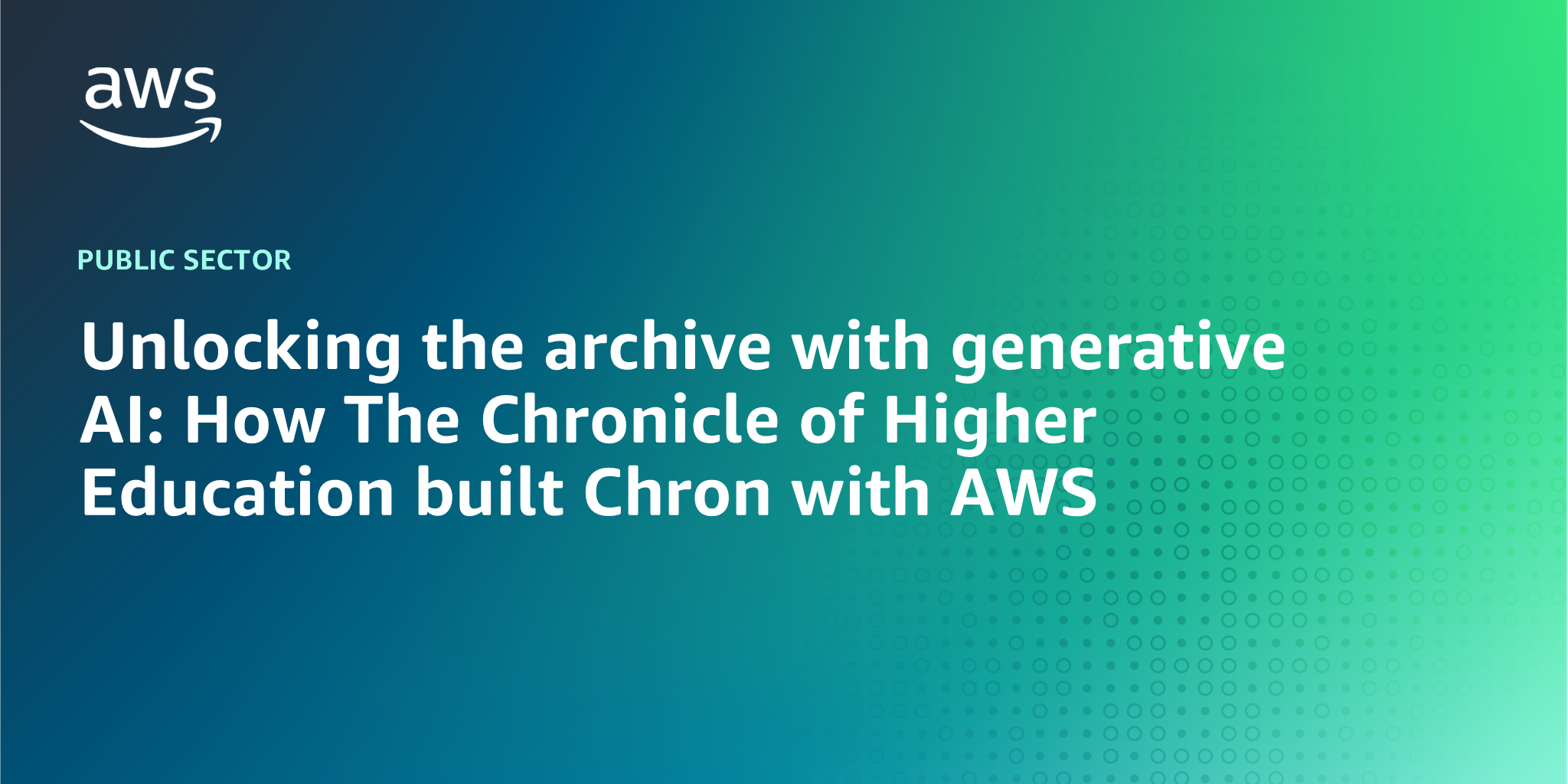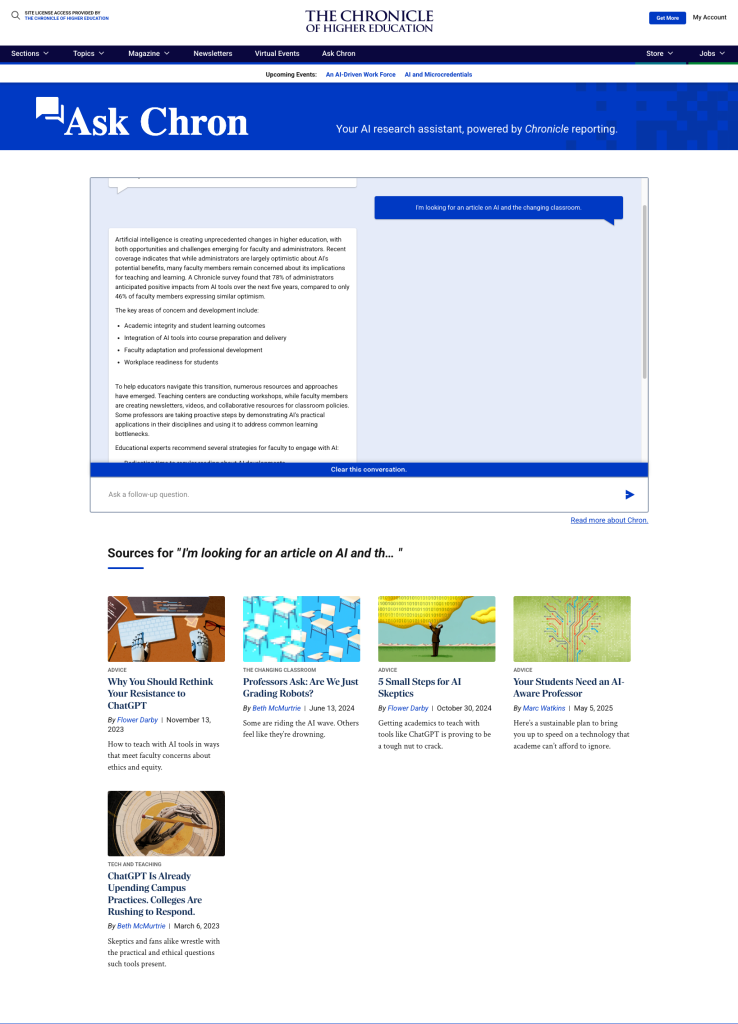AWS Public Sector Blog
Unlocking the archive with generative AI: How The Chronicle of Higher Education built Chron with AWS
In today’s fast-moving higher-education landscape, timely, trusted information has become more valuable than ever. Technological disruption and a growing need for institutional agility have spurred colleges to experiment with artificial intelligence (AI) tools across the academic enterprise. What if higher-education professionals could use a trusted source to instantly search decades of authoritative reporting to answer complex questions about leadership trends, diversity policies, academic job markets, or even the implications of new legislation?
That’s the promise of Chron, a generative AI-powered tool created by The Chronicle of Higher Education in collaboration with Amazon Web Services (AWS). In this post, we’ll explore how The Chronicle harnessed the power of generative AI and Amazon Bedrock to build Chron: a search assistant that unlocks the full value of The Chronicle’s rich archive for educators, administrators, and all higher-education professionals.
A trusted source, evolving with technology
Founded in 1966 and based in Washington, DC, The Chronicle of Higher Education has long been the go-to newsroom covering the ins and outs of the academic world. Serving educators, administrators, researchers, and policymakers, The Chronicle is renowned for its independent journalism and deep insights into the issues shaping postsecondary education.
Beyond reporting, it provides professional-development resources including a job board with 30,000 listings, flagship events such as the annual Chronicle Festival, and sector-leading thought leadership, research, and data analysis via its Chronicle Intelligence unit. With such a broad footprint, The Chronicle could provide a transformative AI solution that would benefit its subscribers seeking insight on pressing challenges colleges face.
The idea for Chron emerged shortly after the release of ChatGPT, when various organizations and businesses began wondering how generative AI could enhance their work. The Chronicle’s editorial and tech teams began experimenting. They wondered if loading full issues of the magazine into an AI model would produce accurate answers, and the early prototypes yielded compelling results. “We realized that if we could build this on our protected site, with our decades of reporting on higher ed, that would be such a compelling experience for our subscribers,” said Chris Contakes, chief technology officer at The Chronicle.
With that vision in mind, the team brought in AWS.
Accelerating innovation through AWS collaboration
The Chronicle has been an AWS customer for years, with 99 percent of its infrastructure already hosted on the platform. This longstanding relationship led The Chronicle to see AWS as a trusted collaborator with which to develop its new generative AI capabilities.
After initial conversations, The Chronicle connected with AWS’s Product Acceleration Team, which specializes in helping customers rapidly build innovative products using AWS tools. The engagement kicked off with a hands-on immersion workshop at AWS HQ2 in Virginia. There, editorial and technical staff worked alongside AWS experts to build foundational knowledge of retrieval-augmented-generation (RAG) architectures, select the right large language models (LLMs), and begin designing a solution tailored to The Chronicle’s goals. “We’re a relatively small company, so having AWS expertise to help us think about what model to use and how to tweak our prompts was hugely beneficial,” said Contakes. The immersion was followed by expert advisory support and rapid prototyping.
When it came to choosing an LLM, The Chronicle prioritized accuracy and ethical alignment. After testing several options, they chose Anthropic Claude Sonnet 3.5 via Amazon Bedrock. The model’s performance, cost-efficiency, and focus on transparency made it an ideal fit for The Chronicle’s commitment to editorial integrity.
Turning an archive into an answer engine
The development process for Chron took roughly six months. Early efforts focused on refining a dataset of over 140,000 articles, with content dating back to the 1990s. The engineering team wrote scripts to export content into a JSON format suitable for the AI pipeline, and built automations so that new content could be continuously added to Chron.
Chron uses a simple and accessible interface, embedded throughout The Chronicle’s site. Since its implementation, users have asked Chron questions such as “How should I prepare for an interview in academic advising?” and “What impact might a new federal administration have on education funding?” The answers are drawn from The Chronicle’s archives, complete with citations and links for deeper reading. “If you’re asking Chron, the answer is coming from our walled garden of content, not from the Wild West of the internet,” noted Contakes. “Another value proposition is that Chron then drives readers deeper and wider into our vast library of articles.”
Throughout the development process, collaboration was key. Editorial staff with deep institutional knowledge played a critical role in validating outputs and shaping the tool’s behavior. And executive leadership championed the tool at every step, seeing Chron not just as a technical project, but as a mission-aligned investment, creating value for The Chronicle’s subscribers and institutional users.
Chron’s impact—and what’s next
Chron launched in beta in December 2024 and entered full production by March 2025. It is now included as a benefit for all Chronicle subscribers and institutional users and has already answered more than 20,000 user queries. The tool has been especially popular among adjunct professors, provosts, trustees, and CTOs, many of whom use it to quickly get up to speed on complex topics.
Feedback has been overwhelmingly positive. Looking ahead, the team is working on a refreshed user experience that will reduce perceived lag time and better signal that answers are in progress. They’re also exploring ways to tailor Chron. “We’re brainstorming how we could leverage this technology, because we do see so many career-related questions on our site, and we think we could use it to help job seekers,” said Contakes.
There are also efforts underway to explore other uses of generative AI as a research tool for staff. More ambitious goals include feeding data-heavy publications like The Chronicle’s yearly Almanac or publicly available datasets into a generative AI tool. “This would create even more easily accessible, compelling insights for our subscribers,” said Contakes.
Connecting credibility with innovation
With Chron, The Chronicle has proven that generative AI can deepen access to trusted knowledge, empower readers to ask better questions, and create new ways of engaging with complex content. Backed by a strong relationship with AWS and a collaborative approach, Chron is a glimpse into the future of information access in education.
Explore the AWS Generative AI Innovation Center to see how AWS helps education innovators build, deploy, and improve technologies that help students, educators, and institutions succeed.

